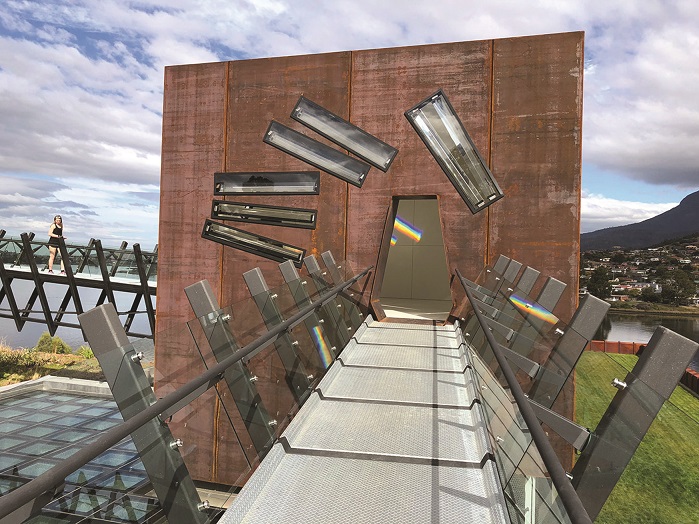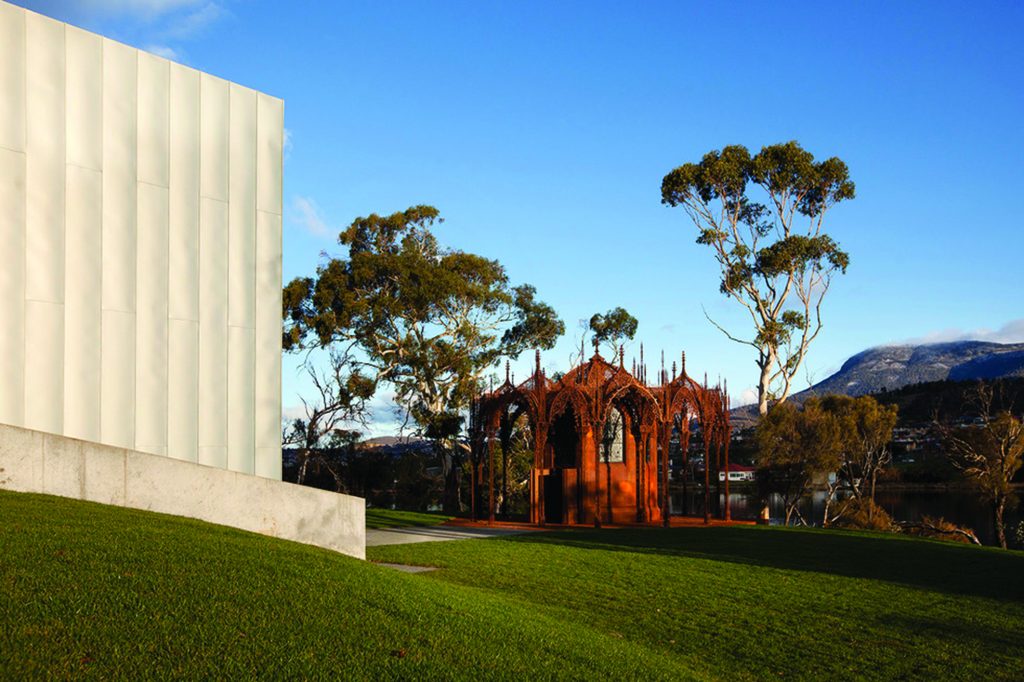A Refresher Course in Being a Child
Museum of Old and New Art Hobart, Tasmania
Tasmania is a long way to go to visit a museum. Nevertheless, the Museum of Old and New Art in Hobart (MONA) is one of the reasons why Tasmania’s visitor numbers have climbed to over a million per year, proving that I am not the only one who has visited Hobart as a museum destination.

The owner of MONA is a local called David Walsh – a professional gambler turned art collector. He says he made his fortune by taking high risks and being lucky. He also says that he felt guilty about making so much money through what he calls an immoral activity, and so decided to build a museum.
“As you descend the metal stairs and reach the bottom most level, you’d be forgiven for thinking you have arrived at a night club, not at a museum.”
Walsh’s taste in art is radical and what he exhibits and commissions is often provocative – it’s his intention to get people talking, believing that controversy is good for business. The New Yorker dubbed him the “Tasmanian Devil”, and MONA “a loss making Avantgarde museum at the end of the world”. Maybe that sounds too much like an American viewpoint, but with running costs three times the amount of his profit, Walsh still needs to make a lot of money by gambling to keep his museum operating and expanding.
MONA opened in 2011 with just two pre-existing modernist buildings above ground. The main exhibition halls are spread over 3 levels, all underground, cut deep into the Triassic sandstone on the banks of the River Derwent. In fact, the more spectacular way to arrive at the museum is by the MONA ROMA fast river ferries from downtown Hobart. If you arrive by car you drive up to the museum through the adjoining winery. Either way, you will appreciate its fantastic location and take in some of the amazing outdoor art. There is Belgian conceptional artist Wim Delvoye’s Flatbed Truck – a symphony of Gothic filigree in laser-cut Corten Steel perched on the terrace overlooking the river; or American light and land artist Charles Ross’ rainbow-filled Spectrum Chamber that forms part of the recently added Pharos wing, which is – as the name suggests – all about light. Light is also the main theme of James Turrell’s Amarna, an architectural outdoor space that transforms sunrise and sunsets into light installation spectacles.


The approach of presenting the collection is relaxed; and, like everything else about MONA, very different to the norm. The exhibition rooms are arranged in a random manner and it is up to every visitor to find their own way through them. Although MONA has originally been called the ‘museum of sex and death’, I found that this two-themed focus has been diluted, tending towards a wider thematic approach. Apart from the continuously changing permanent collection, the museum also curates at least two major exhibitions per year.
MONA aims to shock. It is considered David Walsh’s megaphone (so the website tells us) and it is his capricious personality that he puts on display through it. His private parking spot is marked ‘GOD’; and you will come across explicit signs asking visitors not to fornicate in the vineyards. The language in the texts provided via ‘The O’ – the handheld device that provides all the information on the exhibits – can be rather coarse too. ‘The O’ is unique to MONA, it tracks your path through the museum, and provides information about the artworks in your immediate vicinity at the touch of its screen. ‘The O’ replaces conventional wall texts, hence MONA can keep the lighting in the galleries dim. In fact, as you descend the metal stairs and reach the bottom most level, you’d be forgiven for thinking you have arrived at a night club, not at a museum.
Once you proceed past the cocktail bar you find yourself in front of bit.fall – an installation by Julius Popp – which explores the relationship between humans and technology. It is mesmerising: words which are sourced from actual search engines are formed out of water droplets and fall from a height of two stories in a computer-generated waterfall.
Another good place to start your tour is the Sidney Nolan Gallery which houses Nolan’s Snake – a 46-metre-long undulating display of over 1600 panels in ink, dye and wax crayon on card. This monumental work, inspired by Aboriginal dreamtime, was the starting point for the architecture of the museum – the building was literally built around it. Meanwhile, one room is dedicated to Cloaca, another work by Delvoye. This is a mechanical digestive tract – ‘The O’ will provide you with its feeding times and, yes, you can also watch the machine defecate.
MONA contains so many amazing exhibits, it is difficult to choose which to mention. Anselm Kiefer’s installation Sternenfall forms a bookcase with lead books that seem to be dissolving into a mass of glass shards whose jaggedness leaves you feeling uncomfortable and vulnerable. Pulse Room by Rafael Lozano-Hemmer is made of sensors which pick up your heartbeat and then light up 104 light bulbs in the rhythm of your heart pattern – providing a rather uplifting experience. The view of architectural reflections in the room that houses 20:50 by Richard Wilson, an installation of waist-high pools of recycled motor oil, is extraordinary and well worth queuing for.
Wilson’s work forms part of the Pharos wing, which focuses on light art. All the exhibits here are of a superlative nature; personally, I find those by American light artist James Turrell to be the most compelling, transporting you into a different dimension. Turrell’s installations represent one big contradiction: by obliterating your senses they give you a sensory experience like no other. The entire wing is a mind-bending experience that maybe David Walsh himself describes best as a “refresher course in being a child”.
All of the above is obviously New art, so if you were wondering what the objects are that represent the ‘O’ in MONA, rest assured there are also antiquities, like Greek and Roman coins, Babylonian cuneiform tablets and many Egyptian artefacts including sarcophagi and mummies.
MONA is all about experiences, yet it doesn’t limit itself to experiential art. This contemporary ‘Gesamtkunstwerk’ is also about food – in restaurants where even the crockery and cutlery are art – and wine in decadent bars that comes from a vineyard which is overlooked by exclusive pavilion accommodation. There is a cinema and a research library housing 14,000 titles. There is even an actual wedding chapel on the grounds, another Corten steel art work by Wim Delvoye called a blasphemous temple.
Annual music and art festivals are sponsored by MONA and include events like a nude solstice swim and haunting performance art. No matter how much time you spend there, it does not seem to be enough. This was the first time I visited a museum that I did not want to sit down, let alone leave.
If you are currently planning a trip to Australia, I suggest that you put MONA on your ‘to-see list’. If you aren’t, do the next best thing and find MONA online. Once you start reading about it you will find it difficult to let go of this – to put it once more in Walsh’s own words – “submersive adult Disneyland”.
Follow Karin Grech on her art and culture blog called Bee Wise www.bwiseaftertheevent.wixsite.com/aftertheevent and facebook/bwiseaftertheevent.








